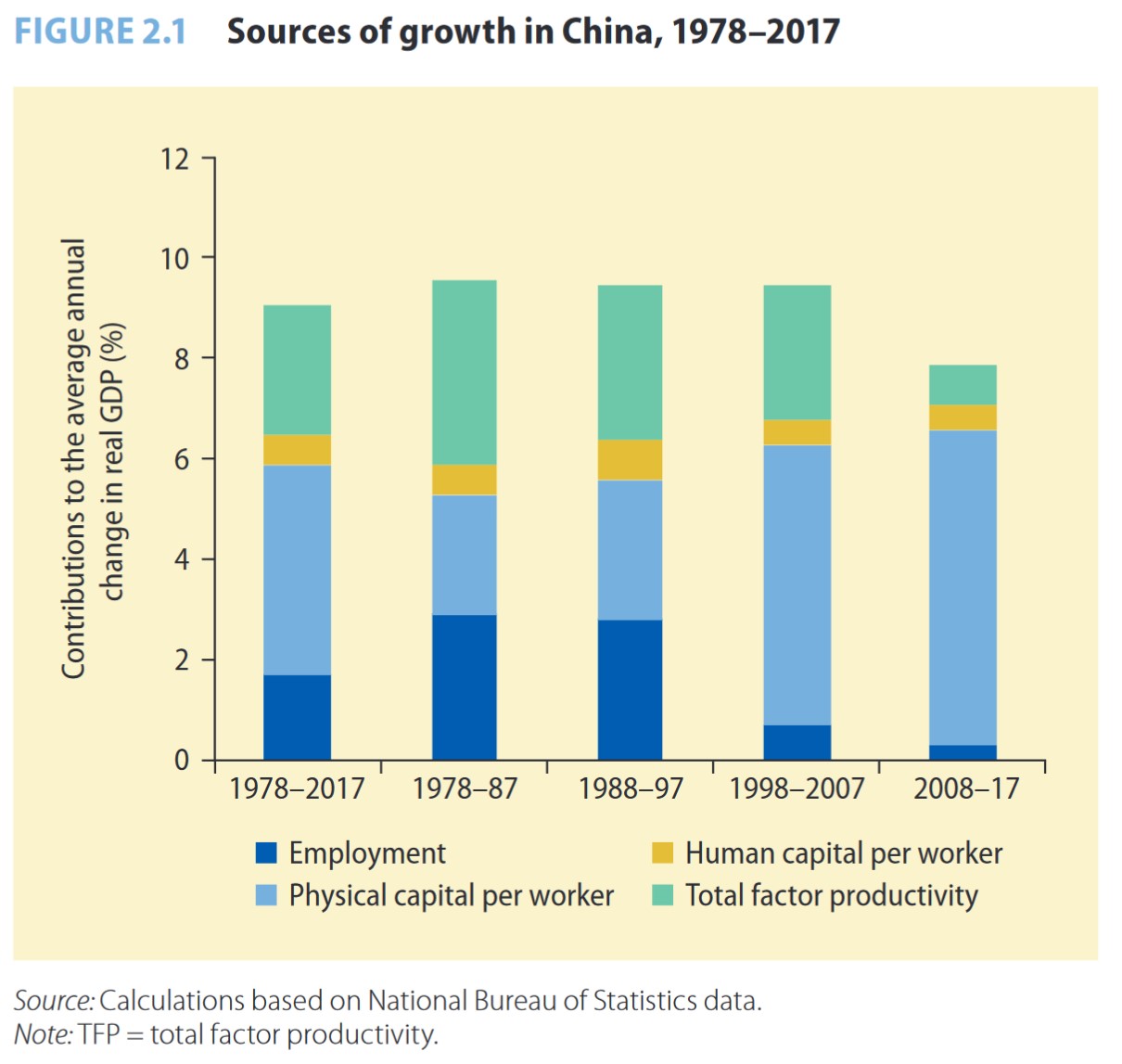|
China: The Continuing Revolution
I.
History
and Environment
A.
Resources -- About 1.4 billion people, more
than one-fifth of the world's population, but only 10 percent
of land suitable for cultivation. Average farmer works less
than one acre, compared with 2 in India and 100 in U.S.
Maps:
Neighbors
Geomorphological
Cities
Provinces
Shanghai Photos
1930s
Colonial
Bund
Pudong
B.
Dynasties and Republics -- Chinese civilization
arose between 3,000 and 2,000 B.C. in Yellow River basin, and
adherents to the "hydraulic
theory of civilization" (following Karl Wittfogel)
suggest that the need for large-scale irrigation required
strong central institutions, leading to "oriental despotism."
For an entertaining overview, see "CrashCourse:
2,000 Years of Chinese History!" and "CrashCourse:
Communists, Nationalists, and China's Revolutions."
Shanghai
Museum Seal Gallery
(Western Zhou through Qing would be more than 2,000 years)
1570
- 1045 BC: Shang Dynasty
There
may have been earlier dynasties in China, such as the Xia,
which, according to legend, arose around 2500 BCE, but the
earliest authenticated dynasty was the Shang, which
evidently was a loose network of feudal states. It
developed an early writing system that was a direct
ancestor of modern Chinese characters.

1045
- 256 BC: Zhou Dynasty
Capital
was established in Haojing, today's Xi'an, until 907AD
551 BC: Confucius is born.
500 BC: Cast iron invented around this time.
403 - 221 BC: The Warring States period.
342 BC: Crossbow first used
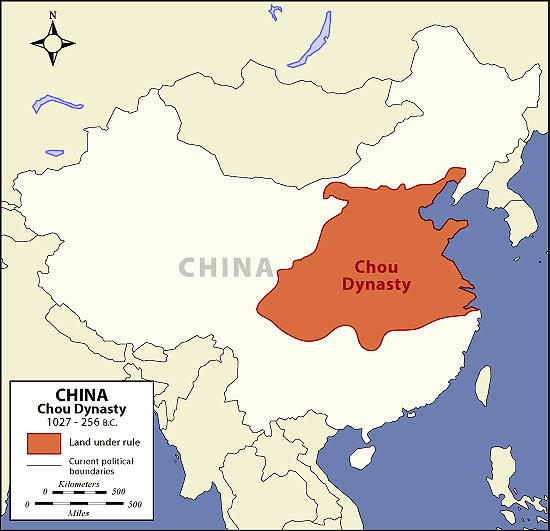

221
- 206 BC: Qin Dynasty
221
BC: Qin Shi Huangdi, the first Emperor of China, had the
Great Wall built to protect his people from the Mongols.

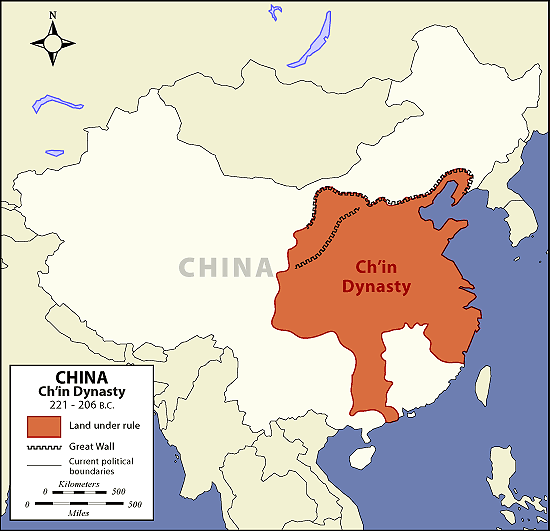
206
BC - 220 AD: Han Dynasty
The
most culturally defining dynasty. Large territorial
expansion. Confucianism gained official status as a
philosophical system and eventually played an important
role in the civil service selection system. Major
advanced in art science, including the invention of
paper in 105 AD. Military success allowed
establishment of the "Silk Road," expending trade and
diplomacy.
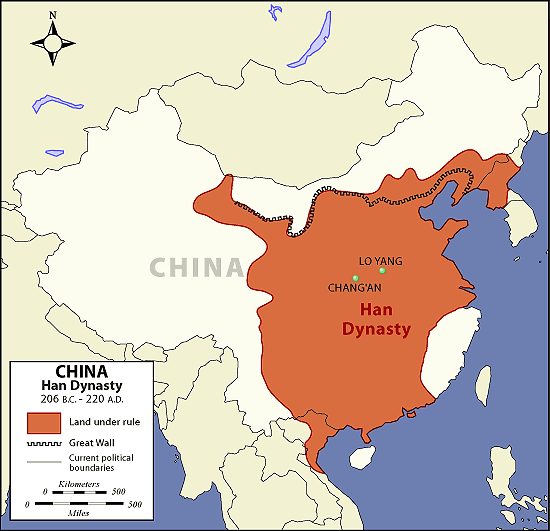
222
- 581: Six Dynasties
250:
Buddhism introduced to China.
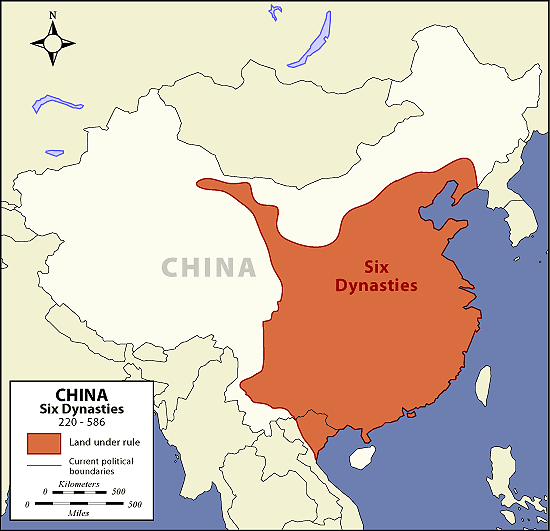
589
- 618: Sui Dynasty
609:
The Grand Canal is completed, connecting Beijing in the
north with Hangzhou in the south, and connecting the
Yellow and Yangtze Rivers. At 1,104 miles, it is the
longest and oldest artificial waterway in the world
(mostly dug by hand), and is now a UNESCO World Heritage
Site.
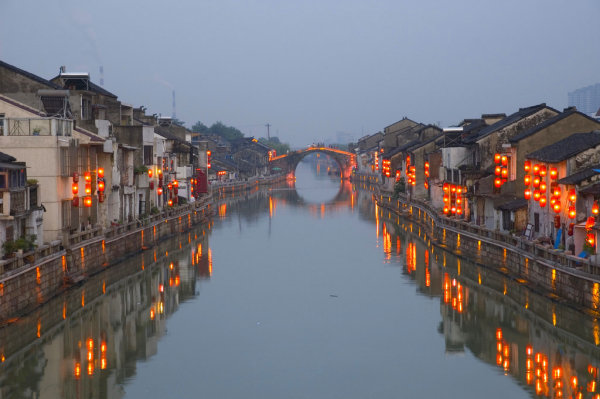
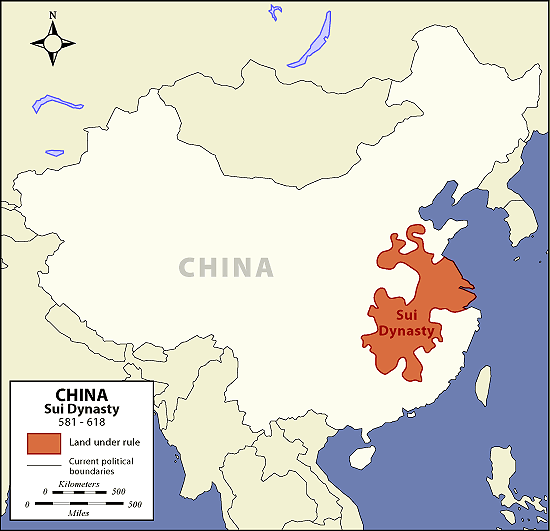
618
- 907: Tang Dynasty
First
for which we have useful economic data, and China seemed
to be more prosperous at this time than any part of
Europe.
Buddhism became a predominant religion for the common
people.
868: Wood block printing first used in China.
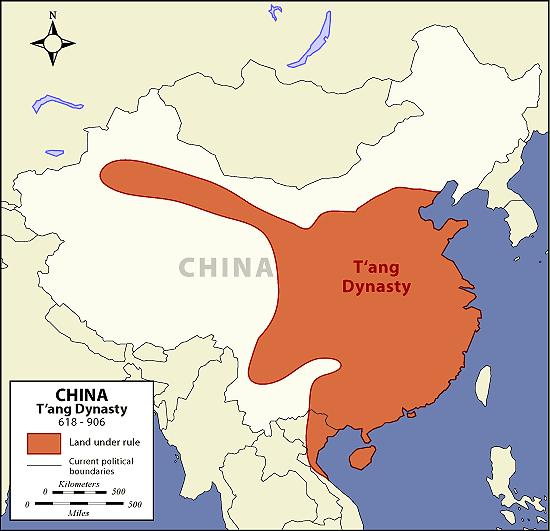
907
- 960: Five Dynasties
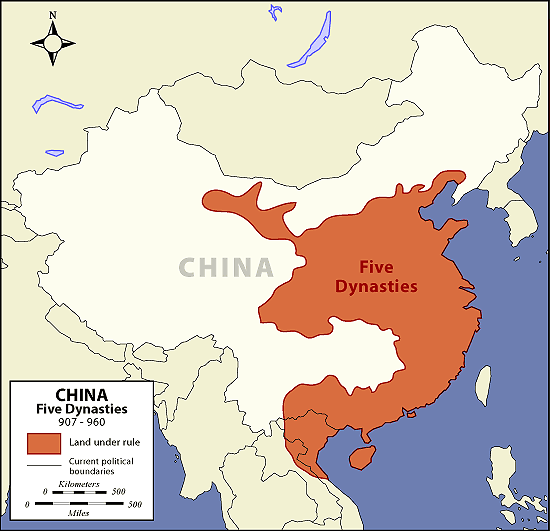
960
- 1279: Song Dynasty
During
the Northern Song (960–1127), the capital was in
Bianjing (now Kaifeng in Henan province) and it
controlled most of what is now Eastern China.
During the Northern Song era, current
research shows that China had the highest
GDP/capita in the world, and that was
probably true for some time.
After the Song lost control of their northern lands to
the Jin Dynasty and then too the Mongols, the Southern
Song (1127–1279) gathered south of the Yangtze and
established their capital at Lin'an (now Hangzhou).
The Song government was the first in world history to
issue banknotes as a national currency
1041: Moveable type for printing invented (400 years
before Gutenberg).
1044: First mention of gunpowder - part of broader
effort to improve defenses.
1200: Genghis Khan unites the Mongol tribes under his
leadership.
1271: Marco Polo begins his (supposed) travels to China.
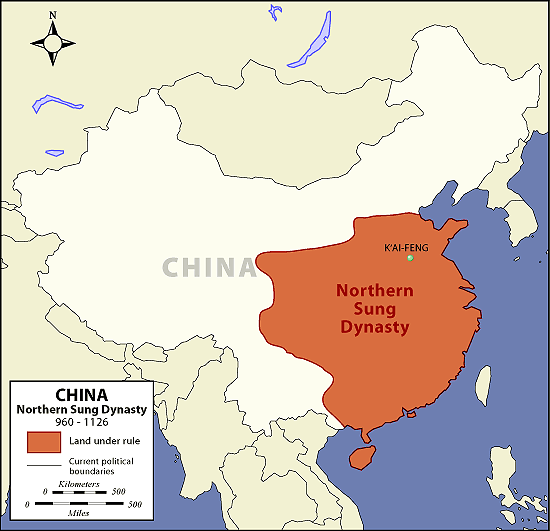

1279
- 1368: Yuan Dynasty
Led
by the Mongols under Kublai Khan, this was the first
non-Han Chinese dynasty to rule all of China - an
embarrassment. While the Mongols destroyed much of
Russia during this period, it was a time of continued
development and cultural diversity in China.

1368
- 1644: Ming Dynasty
China
continued to have a high standard of living during this
time, but Italy pulled ahead by 1300 and England by
1500.
1406-1420: Forbidden City was built, and Beijing became
the new capital, replacing Nanjing. All of this happened
before Columbus's first voyage to the Americas (1492),
but Beijing is still a relatively new capital in the
overall sweep of Chinese history.
High
Culture (see the large Ming vases in Armstrong
Browning Library)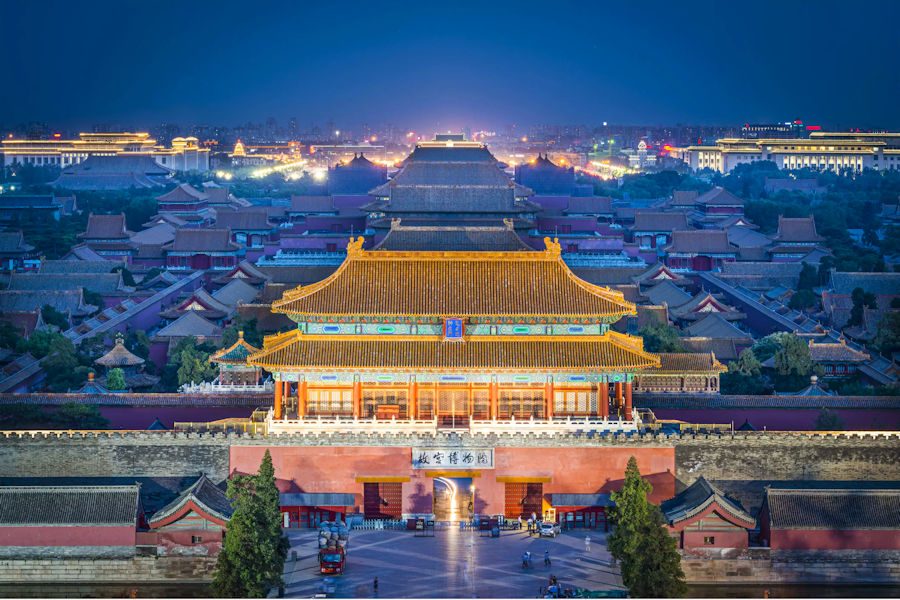

1644
- 1912: Qing Dynasty
GDP/capita FELL
by about 40% between 1700 and 1850, moving it behind all
of Europe.
1839-1842:
Western colonialism begins after British victory in the
first opium war

1912-1949:
The "Nationalist Period" or the Republic
of China.

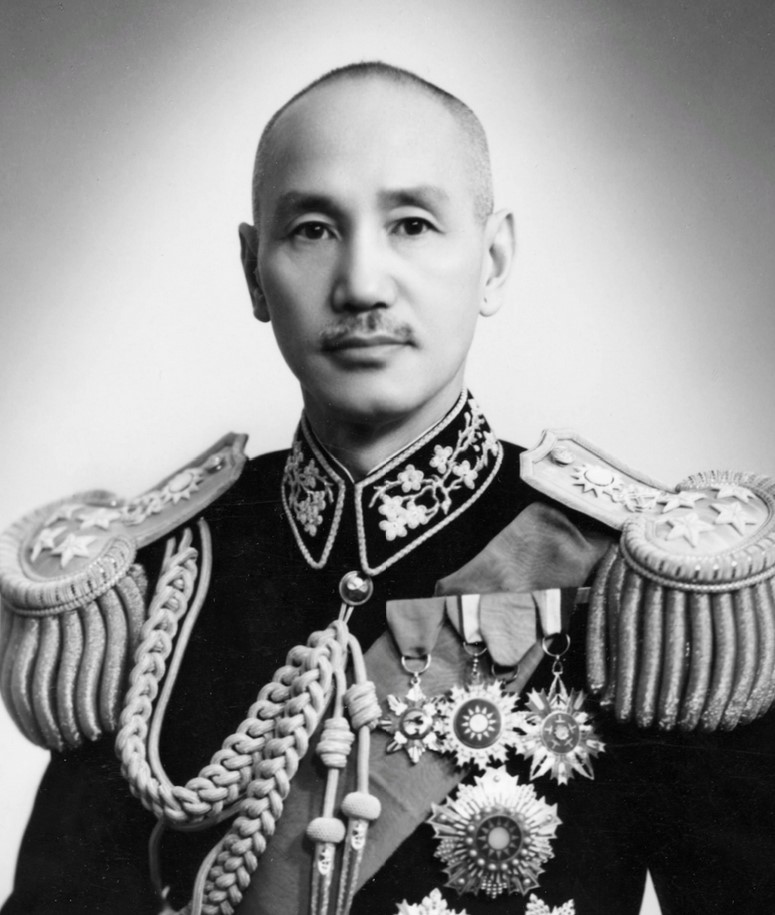
Initially
led by Sun Yat-sen, revered today in
both the Mainland and Taiwan as the Father of Modern
China. Eventually divided by feuding military
officers, and then reunited by General Chiang
Kai-shek, but then driven to Taiwan by Communists
under Chairman Mao. Also, from 1937-1945, large
areas of China were occupied by the Japanese
- another embarrassment.
1949-today:
People's Republic of China
Led
by Mao, Deng Xiaoping, and other leaders, including Xi
Jinping today
C.
Technological
Achievements - Imperial China was most
technologically advanced and literate culture in the world.
Had bronze weapons and tools, gunpowder, movable type,
hemp-spinning machines, agricultural and medical techniques,
algebra, and trigonometry long (often hundreds of years)
before the West.
"The Great Divergence"
- When did Europe pull ahead of China and the rest of Asia in
economic development? The "traditional" European view
was that this happened quite early - maybe in the 1200s. A
more recent "revisionist" view, promoted by scholars such as
Kenneth Pomeranz, suggests that living standards were still
similar in parts of China and the West until the 19th century.
The most
recent evidence suggests that the truth was somewhere
in-between - China started falling behind in the 1300s-1400s,
later than "traditionalists" and earlier than "revisionists."
D.
Causes of Stagnation
1.
Excessive Population Growth
--Mark
Elvin argued that early development of agricultural
and medical technology, limited urbanization, and preference
for early marriages and large families caused excessive
population growth, strained raw material base, reduced value
of labor, and reduced demand for labor-saving technology.
Doesn’t explain why stagnation started before 16th
century.
2.
Nature of Discovery and Dissemination of Knowledge -
China didn’t develop scientific method (Justin
Lin Yifu). European openness, proximity, and guild
system contributed spread of knowledge and connection of one
idea to another (David
de la Croix, Matthias Doepke, Joel Mokyr).
3.
Mongol Domination - Harsh
taxation and servitude during 1234-1368, but the economy was
temporarily opened to foreign trade and technology.
4.
Opium and Colonialism - Opium
addiction reached crisis proportions by 1700s. Efforts to
prevent imports from India led to Opium Wars with Britain
during 1839-1842.
5. Bureaucracy - David
Landes explained the absence of a Chinese Industrial
Revolution in terms of excessive government and market
inefficiency: "The Chinese state was always stepping in to
interfere with private enterprise..."
On the other hand, Dwight
Perkins (Harvard) found that around 1800, there was
only one government worker for every 32,000 people in China,
compared to one for every 700 people in Europe.
5. Isolation
- Dobado-Gonzales
and others suggest, based on price movements and
other market data, that long-distance agricultural markets
failed to integrate in East Asia, as compared to Europe, and
this contributed to the Divergence, from "at least" the 18th
century: "Despite the geographical proximity and ease of
transportation between China and Japan, no statistical
evidence of grain market integration between the two
countries is found during the eighteenth and nineteenth
centuries."
Likewise, in my own (Gardner) conversations with Chinese
scholars, some have suggested that European societies were
open to technologies that flowed from China, but the closed
nature of Chinese society made it difficult to benefit from
technologies developed in Europe during the Renaissance and
Industrial Revolution.

II.
Importing the Soviet Model, 1949-1957
A.
Mao: "The Communist Party of the Soviet Union is our best
teacher and we must learn from it." Thousands of Soviets came
as advisors and thousands of Chinese traveled to USSR for
training.
B.
Agriculture -- Initial land reform, distributing from
former landlords to peasants, quickly followed by creation of
about 800,000 Soviet-style collective farms, each with an
average of about 160 families.
C.
Industry -- Nationalization of industry began gradually
with the "commanding heights" - metallurgy, energy, railroads,
etc.
D.
Educational and Health Reforms -- Outlawed opium,
"barefoot doctors," improved status of women.
III.
The Great Leap Forward, 1958-1960
A.
Communes -- Large Soviet-style collective farms were
merged into even larger People's Communes, each with
3,000-5,000 families, organized in production brigades and
production teams. The commune served as the basic unit of
local government, running schools, clinics, etc. Private
plots, considered a remnant of capitalism, were taken from
families.
B.
Ambitious steel production targets -- Exported grain,
needed for food, to buy equipment for small inefficient steel
mills.
C.
Disastrous results -- Estimates of the number of
"excess deaths" during this period range from 18 million to 56
million.
IV.
Readjustment and Recovery, 1961-1965
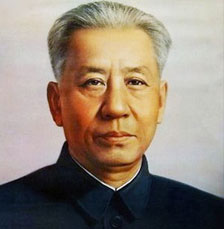 Mao temporarily lost some of his authority to President Liu
Shaoqi (pictured here) and his deputy, Deng Xiaoping, who
introduced moderate reforms in planning, agriculture,
education, and other areas that foreshadowed the period after
1978. A
recent podcast suggested that Liu's leadership style
also foreshadowed the current leadership of Xi Jinping,
because Liu emphasized order and Party loyalty - unlike Mao
who unleashed populist uprisings against the Party and state
bureaucracies.
Mao temporarily lost some of his authority to President Liu
Shaoqi (pictured here) and his deputy, Deng Xiaoping, who
introduced moderate reforms in planning, agriculture,
education, and other areas that foreshadowed the period after
1978. A
recent podcast suggested that Liu's leadership style
also foreshadowed the current leadership of Xi Jinping,
because Liu emphasized order and Party loyalty - unlike Mao
who unleashed populist uprisings against the Party and state
bureaucracies.
Liu and Deng restored priorities with an "Agriculture
First"policy:
V. The Cultural Revolution 1966-1976
A chaotic attempt to replace traditional Chinese culture,
rooted in Confucianism and Buddhism, and Western influences
with a new "proletarian culture." Changed everything from
clothing and music to rejection of Western technology, and
involved a campaign against people who were accused of having
capitalist tendencies. Millions were persecuted, sometimes by
being sent to the countryside for "re-education," and tens of
thousands were executed. The universities were closed for many
years, causing many to lose their chance for higher education.
Industrial production fell for the first time since the
so-called Great Leap Forward.
VI. Transition
of
Power: 1976-1978
Death
of Mao Zedong and Zhou Enlai in 1976 led to power struggle,
eventually won by the reformer, Deng
Xiaoping

VII.
Socialism with Chinese Characteristics (1979-Present)
A.
Ideology
of Pragmatism
1962
Deng Xiaoping proverb: "Yellow cat, black
cat, as long as it catches mice, it is a good cat." Deng
was known as a pragmatic leader.
1978
Deng
restated his philosophy in two compact slogans: "Practice
is the sole criterion of truth" and "Seek truth
from facts." He
visited the U.S. and opened the country to trade, travel, and
investment. In 1980, Baylor received its first mainland
Chinese student since 1949 - Mao Zhiren, who wrote his masters
thesis under my direction about the financial policies of
Alexander Hamilton.
1981
Huge agricultural reform - land redistributed through
the "household responsibility system" (more below under
Agriculture).
1982
Adoption of the new
Constitution that still operates today (with
amendments mentioned below), replacing earlier documents from
1955 and 1978. A
few excerpts:
The People’s Republic of China is a socialist state under
the people’s democratic
dictatorship led by the working class and based on
the alliance of workers and peasants... The leadership of
the Communist Party of China
is the defining feature of socialism with Chinese
characteristics.
The basis of the socialist economic system of the People’s
Republic of China is socialist public ownership of the means
of production... The system of socialist public ownership
... applies the principle of “from each according to his
ability, to each according to his work.”
All mineral resources, waters, forests, mountains,
grasslands, unreclaimed land, beaches and other natural
resources are owned by the State, that is, by the whole
people, with the exception of the forests, mountains,
grasslands, unreclaimed land and beaches that are owned by
collectives as prescribed by law... Land in the cities is
owned by the State. Land in the rural and suburban areas is
owned by collectives except for those portions which belong
to the State as prescribed by law; house sites and privately
farmed plots of cropland and hilly land are also owned by
collectives. The State may, in the public interest and in
accordance with law, expropriate or requisition land for its
use and make compensation for the land expropriated or
requisitioned.
1983
Deng declared that Taiwan (later added Hong Kong) could remain
autonomous and capitalist when reunited with China—one
country, two systems.
1984
Professor
Li Yining of Peking University developed a Marxian rationale
for market reforms—China is still operating at the primary
stage
of socialism.
1986
Negotiations started for China to enter the World Trade
Organization.
1989
Reformist Party leader Hu Yaobang died; students held memorial
service in Tienanmen Square. Demonstrators remained 6
weeks, until troops entered the square on June 4.
Recentralization of authority.
1992
Deng
Xiaoping visited special economic zones in southern
China, promoting reform.
1997
Deng Xiaoping died; successors declared allegiance to
his pragmatic line.
2000
President
Jiang Zemin introduced the 'Three Represents'. “The
CPC will remain successful…so long as the Party represents the
requirements of developing China's advanced social productive
forces, the progressive course of China's advanced culture,
and the fundamental interests of the Chinese people.” Party
membership open to entrepreneurs, effectively reducing the
chance that business leaders would oppose the Party.
Also in 2000
- U.S. Congress granted permanent normal trading relations
(PNTR) to China, clearing the way for accession to the WTO
at the end of 2001. According to Yeling Tan in Foreign
Affairs (March/April 2021), accession initially
strengthened the market reformers, and most of the
requirements for accession were quickly fulfilled:
Tariff rates on foreign imports were slashed, and a
multitude of nontariff barriers were eliminated. The
authority to engage in foreign trade, previously restricted
to SOEs and foreign firms located in special economic zones,
was broadened to all firms, including private Chinese
enterprises. Beijing substantially improved legal
protections for and reduced administrative burdens on
businesses..
2002-2003 - Hu Jintao became
President and Communist Party chief and Wen Jiabao became
Prime Minister. Relatively little change from the policies of
Deng Xiaoping,
but they
were seen by some as weaker leaders, unable to control
bureaucratic opposition to reform.
2004 - Amendments to the Constitution
included new (but limited) protections for private property
("legally obtained private property of the citizens shall not
be violated") and human rights ("the State respects and
protects human rights").

November 2012, while the U.S. was
focused on the 2nd Obama election, Xi Jinping
elected General Secretary of Communist Party and Chairman of
Military Commission; March 2013, also elected President of the
People's Republic. Started a consolidation of power and a
renewed "cult of personality."
2013, China started building new
islands in the South China Sea in an area where territorial
rights were already causing friction between China and several
Southeast Asian countries, and China started building military
facilities on those islands, threatening shipping in that
area, and damaging China's reputation as a friendly nation.
Since 2015 the United States, France, the UK, and other
nations have conducted freedom of navigation operations in the
region, challenging Chinese claims of sovereignty.
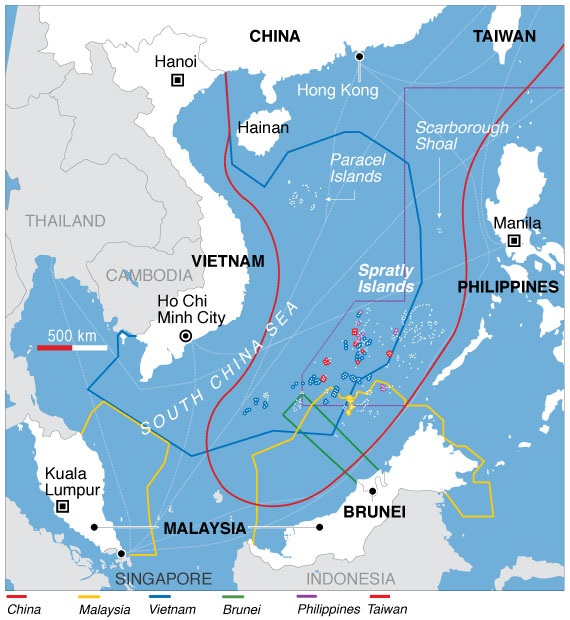
September 2013, During a visit to
Kazakhstan, Xi announced the "Belt and Road" initiative,
whereby China would engage in infrastructure development and
investments in nearly 70 countries and international
organizations in Asia, Europe, and Africa. This has expanded
China's economic, diplomatic, and military power of over a
large area, but at high cost to China and to some of the "aid"
recipients.
- about $1
trillion of construction in other countries, largely
financed by Chinese banks that were required to make
the loans by the government.
- nearly 60% of China's
loans have reportedly been made to countries that
are now in financial distress, compared to 10% in
2010, forcing China to join the Paris Club, an
international organization that negotiates debt
relief for struggling countries.
- From the perspective
of recipient countries:
- Chinese "aid" is
mainly extended in loans rather than grants, and
Chinese labor (rather than local labor) is used for
much of the construction. Allegations of "debt
traps," whereby China takes control of port
infrastructure in non-repaying countries -
allegations of a "new colonialism.".
- In some cases, the
construction quality has been substandard. For
example, in Ecuador, a $2.7 billion hydroelectric
project (the largest source of power in the country)
has developed
thousands of cracks and may have to be shut down.
November 2013, Xi claimed that
"deepening reforms" would allow "market forces" to play a
"decisive" role in allocating resources. However, Chinese
subsidies to target industries have continued to increase.
There are no official and comparable reports for these
expenditures, but recent
estimates by authors at the Center for Strategic and
International Studies (CSIS) suggest that China's
industrial policy subsidies have been - by far - the largest
in the world (see charts below). However, it will be
interesting to see how all of this is affected by the Biden
Administration's enormous forays into industrial policy
under the Inflation Reduction Act, the CHIPS and Science Act,
and the Infrastructure Investment and Jobs Act.

 2014 - The government announced
that it would start building a social credit system.
The announcement explained that the system would encourage
honesty, payment of debts, and social trust. It would begin
with experimentation in major cities, and the goal was to have
a unified national system by 2020, but that goal was not been
met. The city systems collect information on individuals and
businesses, including their financial health and payment of
debts, but also obedience to traffic laws, volunteer work,
health, blood donation, etc. People with low scores can be
placed on various "black lists." So far, the systems seem to
be tracking businesses more than individuals, but, in June
2019, 27 million people already were on the list restricting
air travel and 6 million on the one restricting access to
high-speed trains. Some people are beginning to object to the
growing "surveillance state" with millions of CCTV cameras
everywhere, using face-recognition technology. Source
2015 - Announcement of the "Made
in China 2025 Strategy" that called for
government-supported development of technologies and
production capabilities in high-priority sectors including
artificial intelligence, advanced robotics, electric cars and
other new energy vehicles, 5G information technology,
aerospace engineering, emerging bio-medicine, and others. That
led to impressive advances, but also international concerns
over: (1) compliance with international trade rules, (2)
pressure on foreign companies to share their technologies, (3)
international technological espionage (for example, Meng
Wanzhou, the CFO of Huawei, China's largest private company,
was arrested at in Canada in 2018 and accused of financial
fraud and theft of trade secrets), (4) security concerns over
including Chinese technology in telecommunications and other
systems that are critical for national and global security.
2016 - Donald Trump elected to the
presidency in U.S. after saying that China's trade policy was
responsible for “the greatest theft in the history of the
world.” Between July 2018 and August 2019, the U.S. announced
plans to impose tariffs on more than $550 billion of Chinese
products, and China retaliated with tariffs on more than $185
billion of U.S. goods.
2017 - Internment camps built in
Xinjiang province (far West) that have imprisoned about a
million people without trials, and subjected them to anti-
Islamic behavior modification or "brain
washing." At a lower level of violence, Christian and
other religious communities have been subject to tighter
controls with more house churches closed and foreigners
expelled.
October 2017 - In his speech
to the 19th Party Congress, Xi included a section, Thought
on Socialism with Chinese Characteristics for a New Era,
reaffirming some of the ideas from Deng
Xiaoping and Jiang
Zemin, but also holding out the Chinese system as a
model for other countries, and giving a stronger
reaffirmation of the relevance of Marxism:
"The banner of socialism with Chinese characteristics is
now flying high and proud for all to see. It means that the
path, the theory, the system, and the culture of socialism
with Chinese characteristics have kept developing, blazing a
new trail for other developing countries to achieve
modernization. It offers a new option for other countries
and nations who want to speed up their development while
preserving their independence; and it offers Chinese wisdom
and a Chinese approach to solving the problems facing
mankind."
After
the Party Congress, dozens of Chinese universities established
new academic programs dedicated to Xi Jinping Thought and
Marxism, heightening the new cult of personality around Xi.
Also, see the videos by Zhang Weiwei of Fudan University (here
and here),
making claims for the superiority of the "Chinese Model."
March 2018 - Amendments of the
Constitution removed term limits for Party leader, raising the
possibility that Xi will be a "leader for life." The Chinese
system was now promoted as a "model for other countries."
2020-2023 - The
trade war with China that was initiated by Trump continued
under the Biden administration and then escalated after China
failed to discourage the Russian invasion of Ukraine in
February 2022. In September 2022, U.S. national security
advisor Jake Sullivan announced intention to prevent the
transfer of technologies to China in computing (including
advanced chips, quantum computing and artificial
intelligence), biotechnology, and clean energy. Strong actions
have been taken to prevent transfer of advanced chips and
their technology by U.S. companies and foreign companies using
U.S. licenses.
B.
Agriculture
Before
World War II, traditional system—small-scale
subsistence farming on private land.
1953-1957
- small farms merged into Soviet-style collectives
with average of 160 families.
1958 -
collectives merged into people's communes with
3,000-5,000 families, organized in production brigades and
production teams. The commune served as the basic unit of
local government, running schools, clinics, etc.
1961-1965
- policy of "Agriculture First."
a.
Communes
reduced in size to about 1,700 families.
b.
Incomes
linked to performance of production teams and individuals
according to work-point system.
c.
Families
allowed to operate small private plots.
1966-1978
- progress prevented by Cultural Revolution and the post-Mao
succession crisis.
1981 -
Household
Responsibility System (HRS)
actively promoted by government, Covered 98% of rural
population within 3 years.
a.
Communal
fields were divided into small family plots. Note: In some
ways, this was a return to family farming that was practiced
before 1949.
b.
Households
contracted with production team to cultivate a tract of land
in exchange for fixed quotas of certain agricultural products
to the team at fixed prices.
c.
System
modified in 1984-1985: communes abolished; land ownership
transferred local villages and townships; allowable terms of
the contracts extended to 15 years (30 years after 1995);
household could transfer its contracted land to another
household.
d.
System
was big initial success, based on stronger incentives and more
even distribution of labor effort over the land.
e.
By
1985, grain production returned to lower trend growth and then
declined from 1998-2003. Largely caused by diversion of
land from agriculture and from grain acreage to fruit
and high-value crops. Since 2003, recovery of grain production
explained largely by heavy investments in agriculture.
f.
Recent
research by Chinese scholars at Zhejiang University and
Stanford University suggests that inflexibility of the Chinese
system of land tenure has kept farm sizes very small (about
0.1 hectares or .25 acres), which limits their productivity
and causes overuse of agricultural chemicals, causing
"enormous damages to environmental quality and human health in
China." Recent reforms have made it easier for farmers to
transfer the use rights of their land, aimed at creating
larger, more efficient, farms
g.
On
the positive side, the household responsibility system raised
productivity, allowing excess workers to move to industrial
jobs in the cities. On the negative side, that left an
aging population in charge of the farms, and rural incomes
have fallen behind urban.
China Cereals Area,
Production, and Yield (production/hectare)
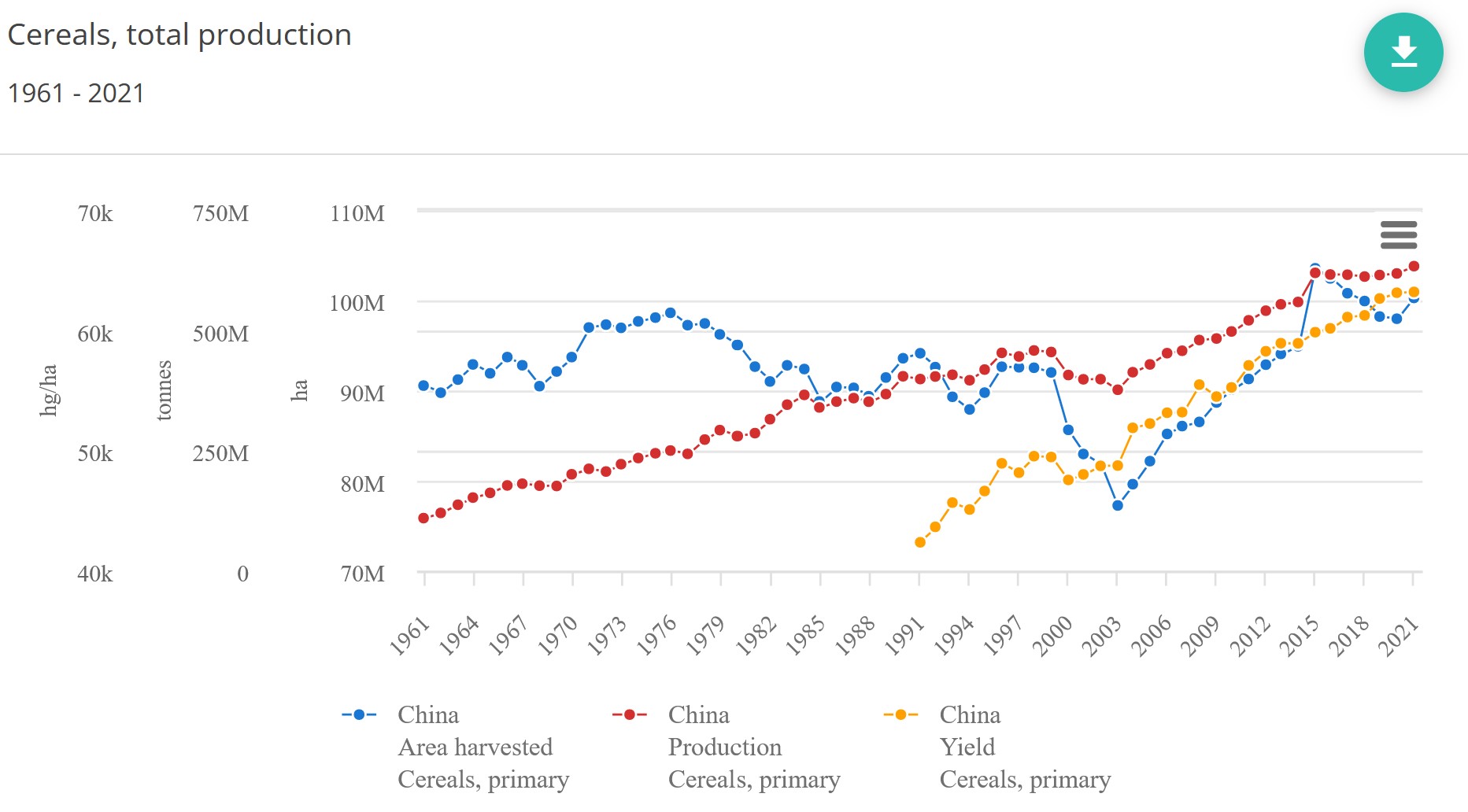
Source: https://www.fao.org/faostat/en/#country/351
C.
Population Policy
Under
Mao - 1949-1970 - large families encouraged, except that Liu
Shaoqi encouraged 2-child families during the 1961-1965 pause.
1971-1978
- "Later, Longer, Fewer" policy encouraged couples to have
fewer children, aimed at 2-child families. Fertility rates
dropped rapidly from 5.8 births per woman in 1970 to 2.7 in
1978.
1979-2015
- The "One-Child Family" policy, which initially was enforced
strictly and pretty horribly (forced abortions, etc, etc).
There were loopholes for ethnic minorities, agricultural
families, and pairs of only-children, so about half of
households could eventually have 2-children.
Beginning
in 2015, two children were allowed for all; raised to three in
May 2021; and then all limits and penalties removed in
July 2021.
Now
the government is pushing a return to "traditional family
values" and larger families, but the population is not
responding. In 2022, China's population declined (by 850,000)
for the first time since 1961, and it fell behind India in
population in 2023. It's expected to reduce the overall growth
rate of the Chinese economy.
The
One Child policy probably supported poverty reduction, but has
caused many distortions of the age and gender structure of the
population and has created a culture of "little emperors and
empresses." A socialism of only-children?
China now has one of the most rapidly aging populations in the
world, following the example of Japan, so India is expected to
serve as a stronger engine of growth in the global economy in
the medium term.
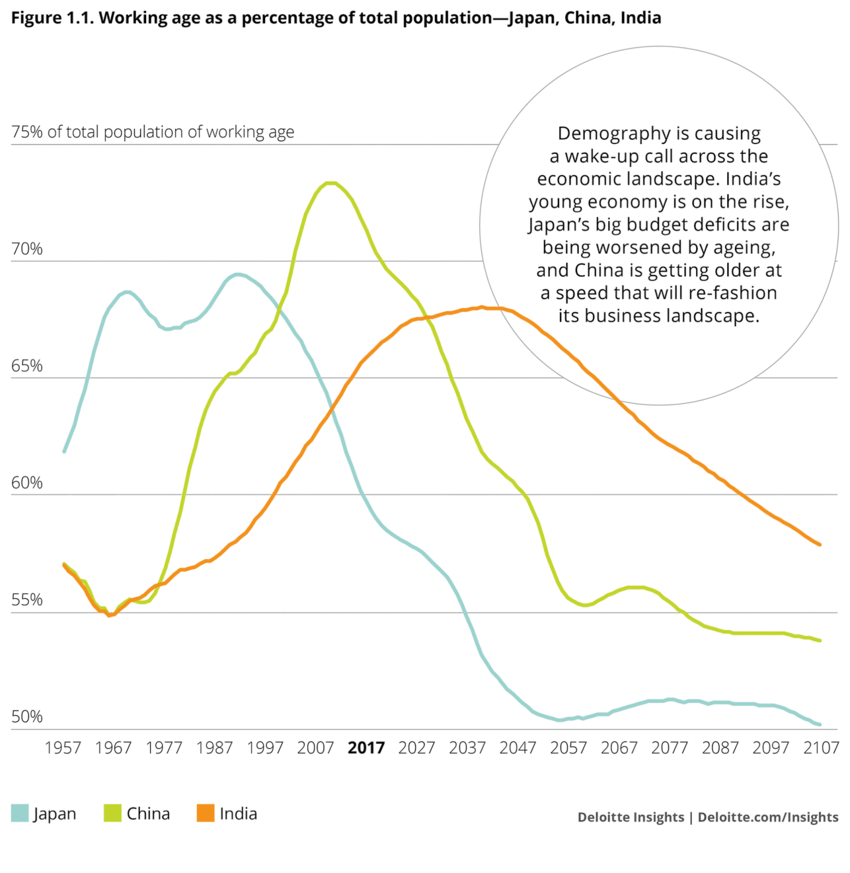
Source:
https://www.weforum.org/agenda/2017/10/china-will-grow-old-before-it-gets-rich/
C.
GDP Growth
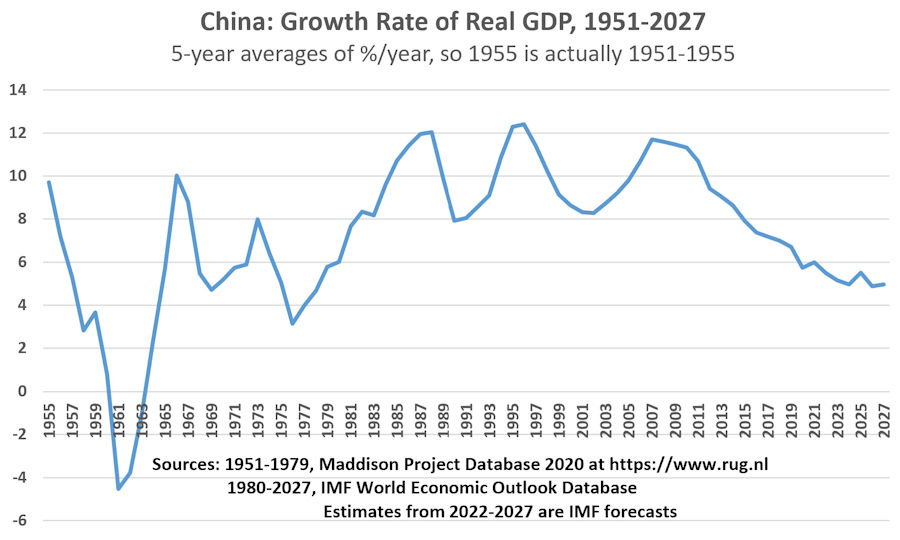
After
tumultuous swings during 1950-1979, the average rate of GDP
growth during 1980-2015 was nearly 10%. During 2016-2021, that
slowed to 6%. During 2022-2027, that's expected to slow again
to 5% or lower. What explains all of that?
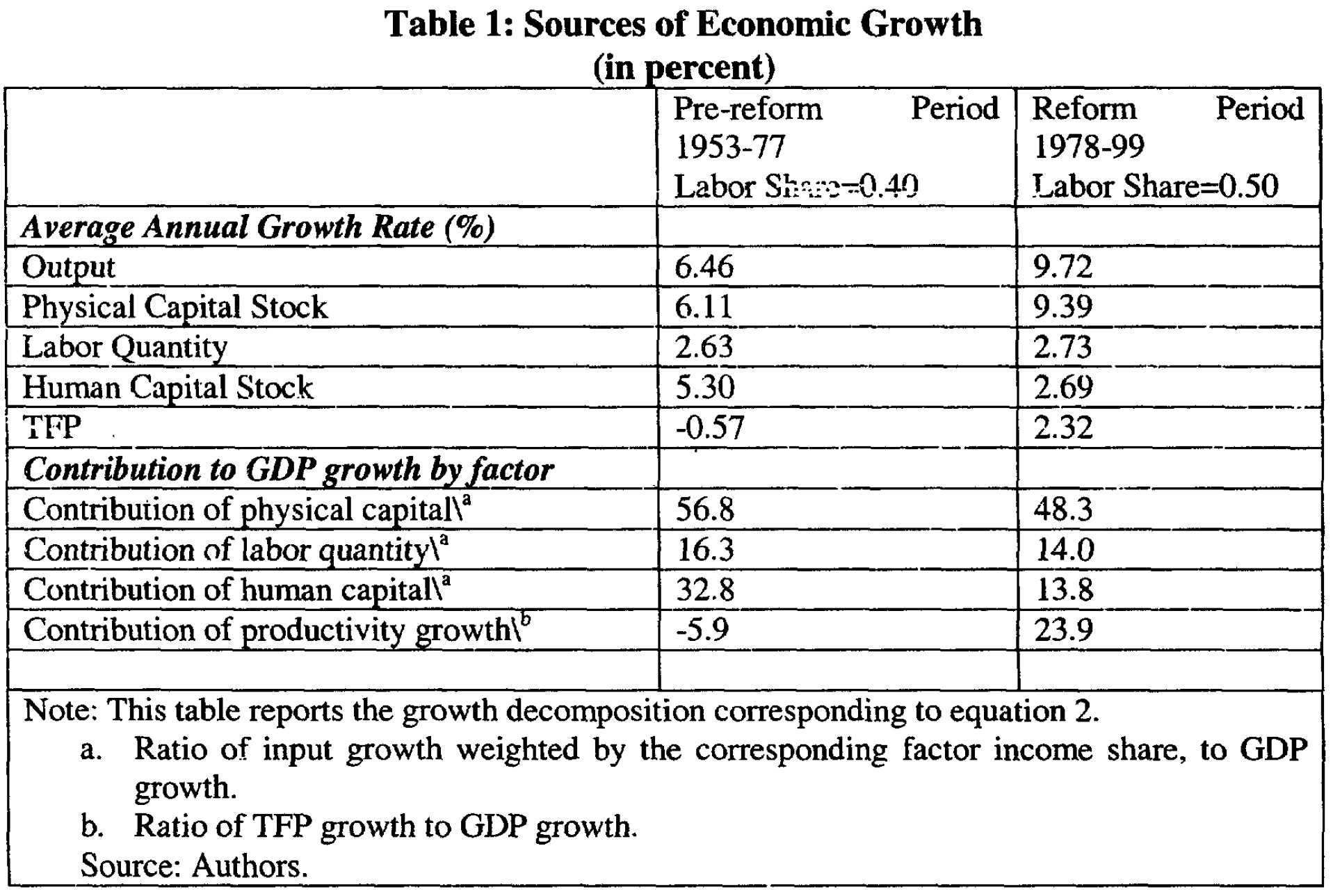
Source: Yan Wang & Yudong Yao, "Sources of China's Economic
Growth, 1952-1999,"
World Bank Policy Research Working Paper 2650, July 2001. During
the Maoist pre-reform era (1953-1977), economic growth was
explained mainly by growth of physical capital and (before the
disruption of the Cultural Revolution) by rising educational
levels. The contribution from growth in the labor force was
small and TFP growth was negative.
NOTE: TFP = Total Factor Productivity = growth of GDP that
is NOT explained by growth of the labor force, educational
levels ("human capital"), or growth of the physical capital
stock. Growth that arises from more efficient use of labor
and capital resources. Extensive
research suggests that maintenance of TFP growth is
important for avoiding the Middle Income Trap and making
progress toward a higher standard of living.
Source: World Bank Group and
Development Research Center of the State Council, PRC.
Innovative China: New Drivers of Growth. Washington, DC,
2019. http://hdl.handle.net/10986/32351
According to estimates of the World Bank and Chinese State
Council (above), economic growth was derived about equally
from growth of the active labor supply, physical capital per
worker, and improvements in TFP during the early reform era
(1978-1987 and 1988-1997). During that period:
a. Agricultural reform (family responsibility) that
raised productivity and generated savings for a high
investment rate and allowed release of workers to higher
productivity industrial jobs in cities.
b. Opening the country allowed inflow of overseas capital and
technology, sources of industrial raw materials, markets for
industrial goods, and improved educational opportunities
c. The working-age share of the population was rising.
During
the years since 1998, the contribution of employment growth
has fallen with a declining and aging population, and the
contribution of TFP has declined because:
a. Getting closer to the global tech frontier, so
improvements grow harder.
b. Attempt to move more workers from manufacturing into
the service sector is likely to reduce productivity growth.
c. Rising trade protectionism, especially after the
Great Recession and the Trump and Biden elections.
d. Authoritarianism under Xi Jinping.
e.
Zero-tolerance COVID policy - Chinese traditional vaccines
provide less protection than Western mRNA vaccines, and that's
especially true for Omicron.
VIII.
How Far Can One Leg Go?
A.
Chinese
advantages in the coming century:
1.
Long
and stable cultural heritage.
2.
Relatively well educated population and very high levels of
investment in R&D .
3.
Untapped natural resources.
B.
Challenges:
1.
Slowing
economic growth, even before COVID-19 and rising debt levels
2.
Necessity of transitioning from export-based development to a
more internally-based system and capital dependent growth to
higher productivity.
3.
Need to strengthen the independence of financial institutions
and access of the private sector to financing. According to a
World Bank survey, many Chinese firms say this is their most
significant constraint. Private firms are almost twice as
likely to be turned down for a loan than state-owned
enterprises.
4.
Rising authoritarianism, ideology over pragmatism, and cult of
personality under Xi Jinping. Is continued economic growth
possible without political reform?
5.
Declining international approval, driven by backsliding on
"one country, two systems" in Hong Kong; alleged COVID-19
cover-up; treatment of Uyghur Muslims in Xinjiang and other
religious groups; South China Sea islands and shipping
disputes; large trade imbalances; technological espionage and
other tech-based security concerns, etc, etc. Opinions were
already growing more negative before the COVID crisis,
and have
taken another dive afterward. Many countries are growing
more protectionist generally, and especially so with China.
Editorial Comment: While our relationship with China will be
more complicated going forward, it will be impossible to
address the big global problems, such as pandemics, climate
change, cyber-terrorism, etc, etc, without some level of
dialogue and cooperation. Also, if we are going to influence
Chinese behavior, we will do that more effectively in
cooperation with our allies who share many of our democratic
values.
|




















 Mao temporarily lost some of his authority to President Liu
Shaoqi (pictured here) and his deputy, Deng Xiaoping, who
introduced moderate reforms in planning, agriculture,
education, and other areas that foreshadowed the period after
1978.
Mao temporarily lost some of his authority to President Liu
Shaoqi (pictured here) and his deputy, Deng Xiaoping, who
introduced moderate reforms in planning, agriculture,
education, and other areas that foreshadowed the period after
1978. 








